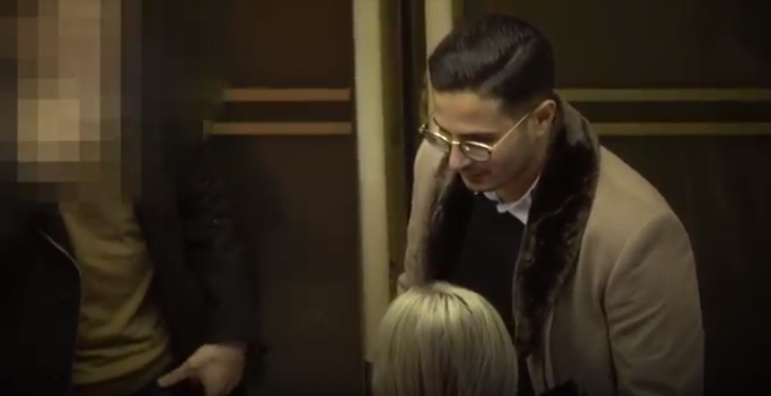Indonesia | Русский| বাংলা | العربية | 中文

Screengrab from a video by Norway’s VG, whose reporters revealed how an Israeli man posed as the playboy son of a diamond oligarch to con several women out of millions of dollars.
In February, Norway’s best-read newspaper, VG, produced a complex, six-month investigation of a con man who met his victims through Tinder. The series attracted more than two million readers, and prompted numerous follow-ups by global media. The publication’s early data suggested that about 50% of those who opened VG’s “Tinder Swindler” story read the deep investigation all the way to the end, and its English-language readers jumped from near zero to around 500,000 for the story.
It was an investigative story of, by and for the smartphone, but which deliberately reduced reader choices with automated short video and text dialogue streaming. All readers had to do was scroll.
VG’s team of reporters revealed how an Israeli man posed as the playboy son of a diamond oligarch to con several Scandinavian women out of millions of dollars. They showed how a fugitive posing as “Simon Leviev” used private jet travel and a fake entourage to extract loans from Tinder dates, where each victim was used to fund the seduction of the next.

Shimon Hayut, also known as “Simon Leviev.” Photo: Tore Kristiansen / VG
After confirming his identity as Shimon Hayut, VG revealed his victims’ stories, set out the criminal probes across four countries, physically traced his origins to a home in Israel, and — after a six month search — tracked him to a hotel in Germany.
And they told this whole story (in the English-language version) in just 924 words of traditional text.
In effect, the short sentences served as captions for a series of subtitled videos and phone text streams.
Natalie Hansen, the co-lead reporter on the project, says the multimedia presentation was chosen over long-form text and video documentary because of the cooperation of the original source.
Cecilie Fjellhøy, a Norwegian user-experience design student, approached VG last year after Hayut had extracted more than $240,000 in bank loans from her. Hansen says that, crucially, Fjellhøy was willing to surrender all of her WhatsApp messages and cell videos relevant to her relationship with Hayut.
“We’ve done a few projects similar to this before, but none as successful as this one,” said Hansen. “Last year, we used at least a similar technique on another swindler story, except there was much more text in that one, and less mobile. After I read through the 400 pages of WhatsApp correspondence from our primary source, it became clear we should recreate a lot of the conversations, and make it for mobile. That is also because most people who read VG do it through mobile.”
Going Mobile for Sustainability
Owned by Scandinavian media group Schibsted, VG — abbreviated from Verdens Gang — was launched by Norway’s World War II resistance movement, and is now the country’s largest online newspaper. It also has a sister TV station.
Like many major publications, VG has been forced to make major cuts to its editorial staff since its the digital revolution; the last downsizing took place in 2014. Yet its online readership has grown to 1.8 million unique visitors per day.
Lars Håkon Grønning, editor of VG, says the editorial staff had stabilized at 260 in the past three years, and it had been able to retain a robust investigative unit of 12 reporters. Indeed, its footprint has grown with the new multimedia approach to in-depth stories, with video reporters like Natalie Hansen now joining the investigative journalism unit on big stories.

Screengrab from VG’s “Tinder Swindler” investigation, which recreated WhatsApp conversations between a conman and one of his victims in real time.
Grønning says being agile with multimedia and particularly mobile platform presentations is key to sustainability.
“If you look 10 or 15 years back, we have maybe half the editorial staff we had before,” says Grønning. “But I am becoming more optimistic now — 2019 will be the first year where we will cover all our costs through digital; print income is no longer critical to keep staff. We have around 85% direct traffic, so we are not dependent on Facebook, for instance, to get readers. Print is declining dramatically; I don’t think we will have print at all in five years.”
VG publishes in Norwegian, but has run occasional English-language versions for stories with global potential. Hansen said: “The main reason for doing [the Swindler piece] was to reach out to other victims all over Europe.”
Although he signed off on the decision, Grønning says he deferred to the judgement of the lead reporters on the Tinder Swindler investigation – Hansen and Kristoffer Kumar – on the choice of a mobile platform presentation. He says that, given VG’s 80% mobile consumption, the reporters’ social understanding of shorter attention spans and mobile use was the deciding factor.
Hansen says: “I don’t think you can do it like this for every [investigation], because the material we had – getting into the personal material in Cecilie’s phone – was really unusual. It could have worked as a video documentary also, but that takes more time, and attention span is shorter today, and it was easier to do transitions with short texts.”
However, Grønning admits that the choice did come at a cost for the weekend print edition: “To be honest, we just [cobbled] something together for our weekend magazine — it was okay-minus; nothing to brag about. But online, it was great.”
The need for hyper-simple writing to accompany the clips also presented challenges for the creative writer on the project: “The language had to be really, really simple,” says Grønning. “And the writer on our story really loves to write creatively, so it was a bit of a struggle for him to have to write so simply; no fancy sentences anywhere.”
Another innovation in the story was that it showed the reporters working the story in real-time.
In one sequence, Hansen is seen narrating the hunt for Hayut while rushing through Munich’s airport, and then looking at her phone and saying: “I’ve now received a picture from the photographer of [Hayut] and the Swedish woman. Wow – he’s now in Munich!”
Showing Their Work
Leading journalism advocacy organizations have recently called for greater transparency in presenting corrections and the reporting process to readers. In March, Marty Baron, executive editor of The Washington Post, emphasized the growing need for reporters to be seen doing their work, in a speech at the Goldsmith Prize for Investigative Reporting.
Hansen agrees that behind-the-scenes footage could indeed boost reader trust, but says the decision to show footage of the reporters flowed naturally from a unique feature of mobile platform presentation: “It really lets readers experience the story ‘in the now.’ The main reason I was in front of the camera was it was easier for good storytelling; you can experience what happens when it happens — the ‘now’ feeling of video. That was always a feature. After I edited the interview with Cecilie in a raw clip, we matched her points to the timeline on the WhatsApp log, and our technical guy made it work automatically when you scroll.”
The text itself also reflected that “now” sense, with present-tense language.
Grønning says: “Natalie and Kris worked extremely hard on this – they even put their alarms on at 3 a.m. to write in the dialogue to make the time on the messages coherent with the screenshots we got from the source.”
He says the reach of the story was such that even a Hollywood movie agent had reached out to VG.
Grønning adds: “To be honest, we weren’t sure this was the way to go; we wanted to experiment. But this is definitely the future. If you are working on a big story, you have to ask yourself: ‘What digital technique will suit this story?’ And it is crucial to have those discussions from day one, in the research phase, because you have to gather material you need as you go.”
According to Grønning and Hansen, elements that made the Swindler mobile presentation work included:
- A primary source willing to share revealing texts and video, and forgo their privacy rights;
- Simple language in short supporting text paragraphs;
- The use of central documentary evidence in images – such as the document showing Hayut’s forged bank deposit slip, where he pretends to have repaid the loans to one victim;
- A design team able to automate video and texting streams, and reduce reader choice;
- Video with official corroboration — such as their interview with an Israeli police investigator, “despite our fear that it might seem boring”;
- Behind-the-scenes clips of reporters on the trail;
- Willingness to sacrifice quality in the print version; and
- Collaboration with outside reporters, if necessary – in this case, Israel’s Uri Blau.
 Rowan Philp is a multiple award-winning journalist who has worked in more than two dozen countries. Currently based in Boston, Philp was the chief reporter and London bureau chief for South Africa’s Sunday Times for 15 years.
Rowan Philp is a multiple award-winning journalist who has worked in more than two dozen countries. Currently based in Boston, Philp was the chief reporter and London bureau chief for South Africa’s Sunday Times for 15 years.
